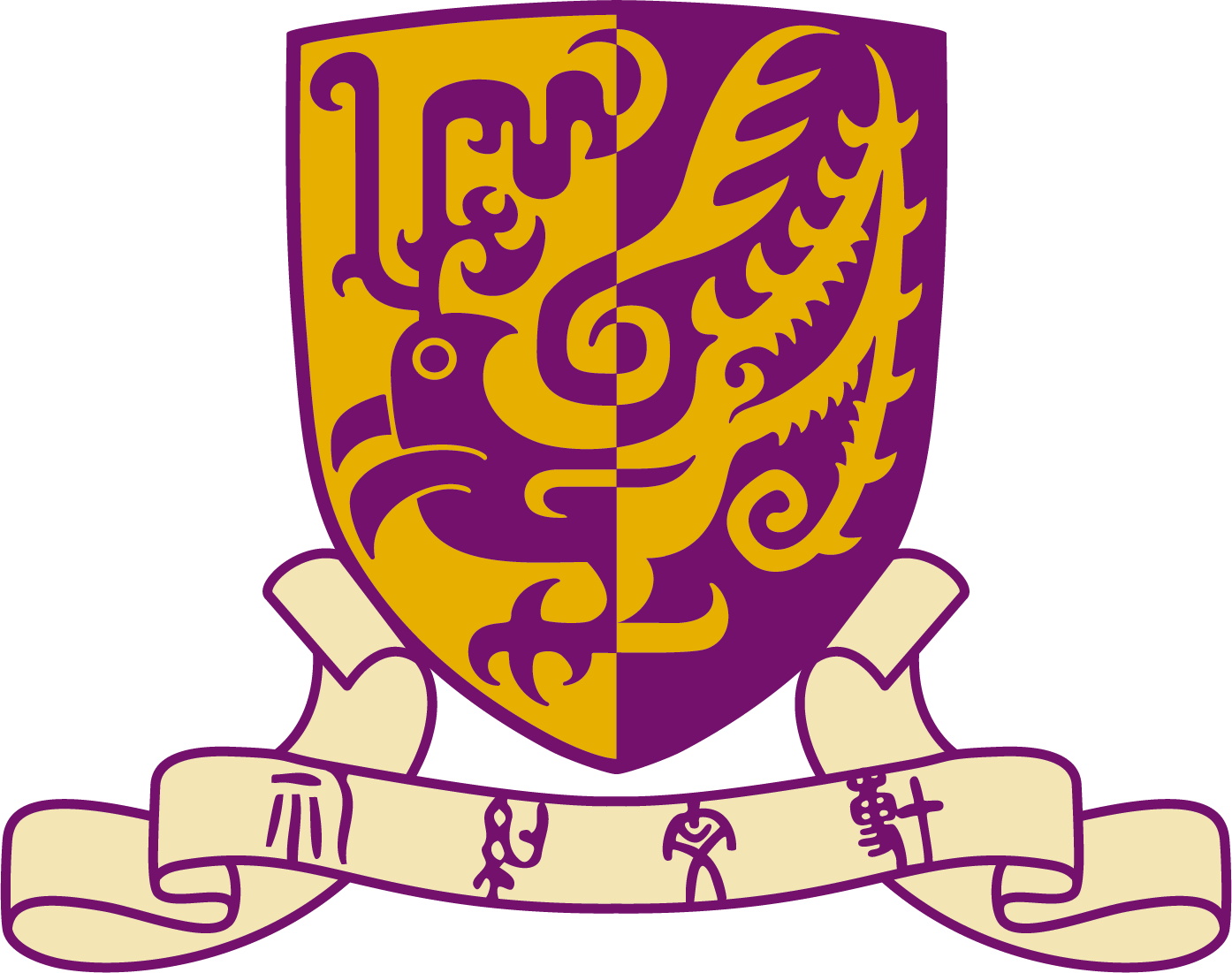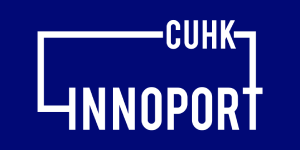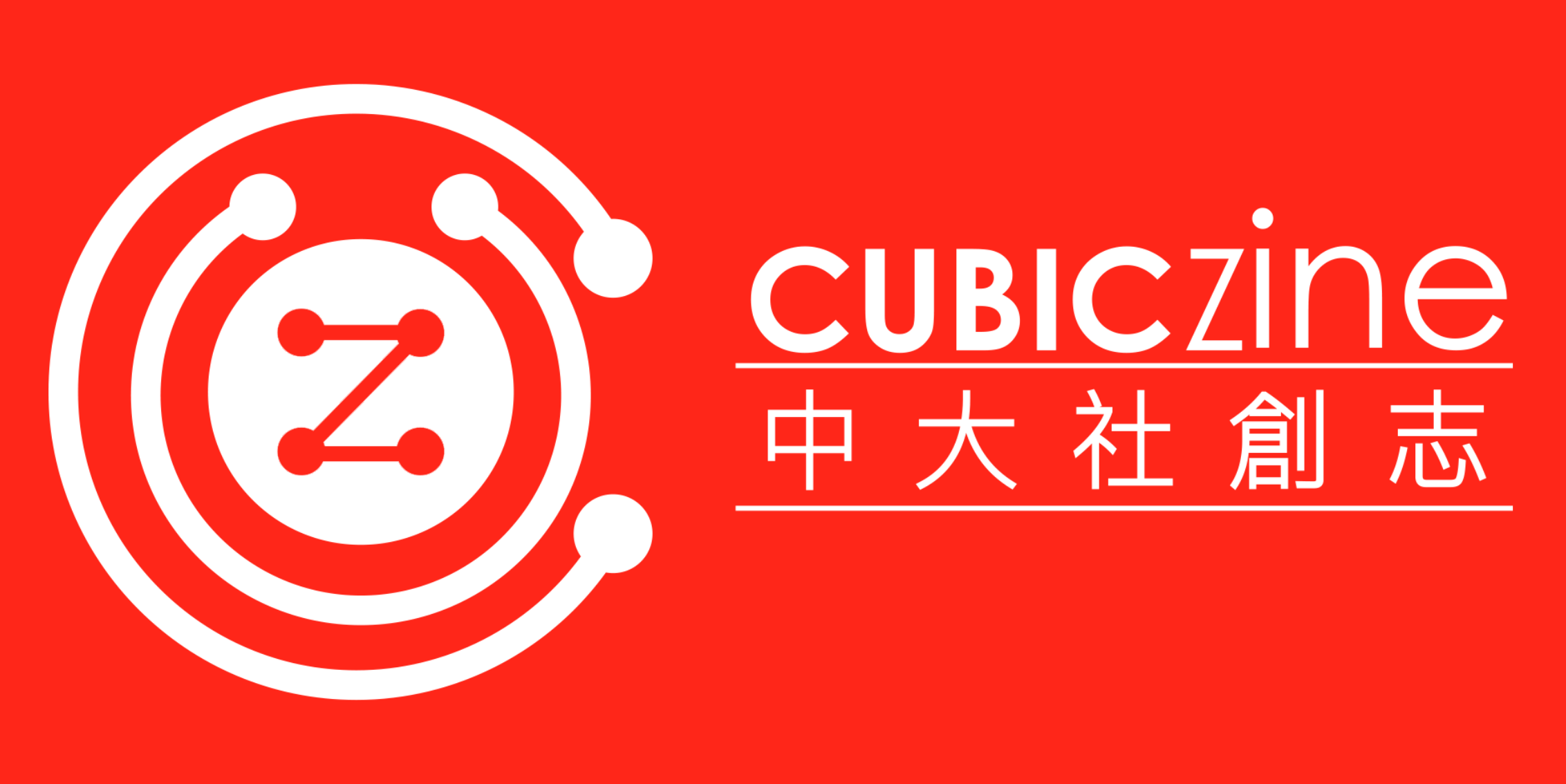Knowledge Transfer
- Details
- Category: Knowledge Transfer
- Details
- Category: Knowledge Transfer
-
What is the IP commercialization process through ORKTS?
The University’s streamlined commercialization process begins when a CUHK researcher discloses a potentially important invention. Along the process, the researcher receives professional services provided by specialized teams at ORKTS. First, the IP and Technology Licensing Team (IPTL Team) assists in developing a suitable IP and commercialization strategy. Then, the invention will be packaged and promoted to attract potential business partners through various marketing channels (e.g. web-based marketing campaigns, business matching and international exhibitions). Once a suitable business partner is identified, ORKTS will help the researchers to develop concrete collaboration proposals and draw up a contract acceptable to all parties.
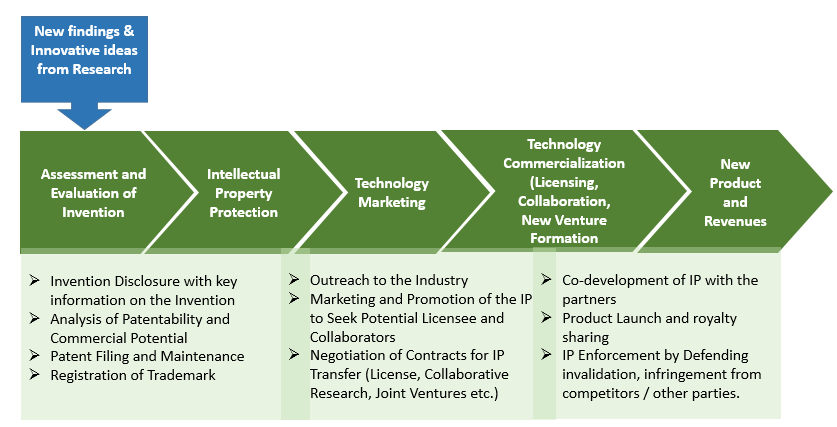
-
What are the IP services available at ORKTS?
Universities make an important contribution to society by discovering and developing innovative technologies that directly or indirectly affect the way we live. One of the most important functions of ORKTS is to help commercializing new technologies developed by CUHK’s scientists and to bring them to market as practical propositions. The Intellectual Property and Technology Licensing Team (IPTL Team) at ORKTS plays a vital part in this process of technology transfer, and works closely with the University’s researchers at all stages of IP development. The team provides a wide range of services in IP management from patent application, formulation of IP strategy, IP licensing, contract negotiation, and management of post-licensing compliance.
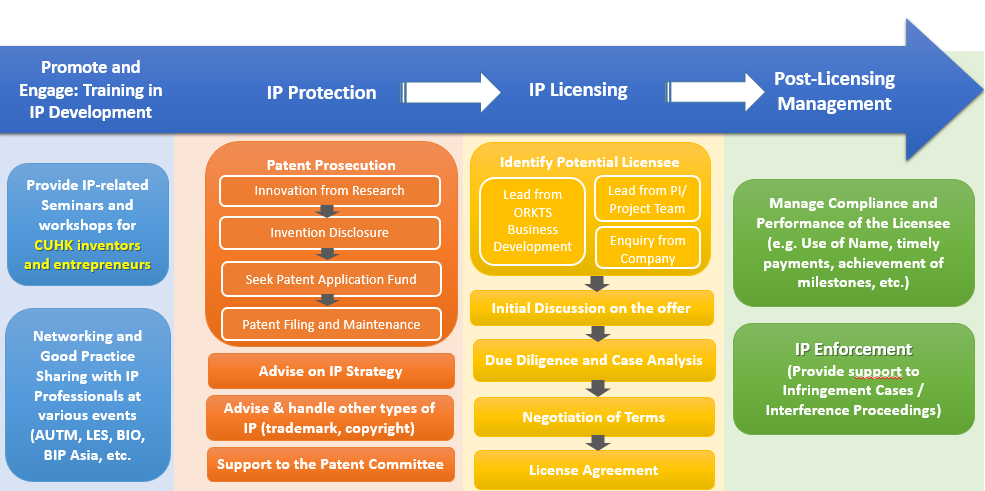
-
What is the University’s policy on IP?
Please refer to the University’s Policy on Intellectual Property for details.
-
What are the different types of IP?
ORKTS helps CUHK researchers to protect and commercialize their research output based on its nature. The most common form of protection for inventions are patents and copyrights.
Patents
A patent protects an invention and grants the inventor(s) the rights to exclude others from using the invention for a limited period of time, usually 20 years from the date of first filing.
To obtain patent protection, inventor(s) needs to file a patent application with the Patent Office of a particular jurisdiction of interest. The application must satisfy the patentability requirements and overcome any rejection raised by the examiner. In most countries, the patent laws would require an invention to be novel, inventive (unobvious), industrial applicable (usefulness), and fall within the scope of patentable subject matter.
To initiate the patent filing at CUHK, please refer to Q14 “How ORKTS can help with my patent filing?” for further details.
Copyrights
A copyright protects literary and artistic works, including writings, music, and works of the fine arts, such as paintings and sculptures, and technology-based works such as computer programs and electronic databases.
Copyrights protect the expression of an idea but not the idea itself. Unlike patents in most countries, there is no need to file any application or to go through any registration before a piece of work could enjoy copyright protection. In Hong Kong, copyright is an automatic right and it arises when the work is created. In some countries, e.g. the United States and Mainland China, registration of copyright is available. To be protected by copyright, the work must be original. Nevertheless, the definition of original varies from country to country, and it is often determined by case law in common law countries.
ORKTS will record a to be licensed research output with a Copyright and Software Disclosure Form. Colleague who has copyright protectable research output that is expected to be licensed-out could contact the IP and Technology Licensing Team (IPTL Team) to obtain a Copyright and Software Disclosure Form to initiate the process.
Other types of Intellectual Property include Trademark, Registered Design, and Trade Secret, Protection of Layout-Design (Topography) of Integrated Circuits and Plant Varieties Protection, which are all recognized by Hong Kong laws. To know more about other types of Intellectual Property, please contact the IPTL Team as to which type of Intellectual Property protection is suitable for your research output. Alternatively, you may visit the website of Hong Kong Intellectual Property Department for more information. -
How do I access the FREE online-course on IP basics?
Developed through the partnership of National Academy of Inventors (NAI) with The Michelson Institute for Intellectual Property and NAI Fellow Dr. Gary K. Michelson, this 3.5 hour FREE of charge IP course on the Udemy.com platform covers IP basics and suitable for learners at all levels, particularly beginners. Please click here for enrollment.
-
What are the different types of patent applications and procedures?
Patent protection differs from one territorial jurisdiction to another, and here are several different types of patent applications:
US Provisional Patent Application
A Provisional Patent Application is a relatively simple application that does not require claims to be listed. This type of application is available only in the United States. No examination is required for a provisional patent application. Attorney time could be minimal if so desired. Applicants should note, however, that a regular application must be made within 12 months from the date of the provisional filing. The benefit of filing a US Provisional Patent Application is that the application quickly establishes a “priority date” of which the invention is filed, while giving the inventors additional time to decide whether a regular patent application should be filed within the next 12 months. The cost of filing a provisional application is much less expensive than that of filing a regular (non-provisional) application.
Regular patent application (Non-provisional)
A Regular Patent Application requires a full specification and a list of claims. The application will be examined substantially by an examiner of a national patent office. The specification and claims will be published 18 months after the date of filing.
PCT (Patent Cooperation Treaty)
A Patent Cooperation Treaty (PCT) allows an applicant to make a single application, while preserving his or her right to file separate patent applications in some or all of the PCT member states within 30 months from the earliest date of filing. The current PCT member states are listed here.Reform of the Patent System in Hong Kong
A new patent system has been launched in Hong Kong on 19th December, 2019. It introduces an original grant patent (OGP) system for standard patents, refines the existing short-term patent (STP) system and introduces an interim regulatory measure of prohibiting use of certain confusing or misleading titles and descriptions relating to patent practice in Hong Kong. For further details, please refer to the website of Hong Kong Intellectual Property Department. -
Who will be the inventors?
Unlike authorship of scientific publications which may include a person as author because he/she made a substantial contribution to the findings, or for professional courtesy, inventorship is legally designated. An incorrect declaration of inventorship may jeopardize the validity of a granted patent. The threshold question in determining inventorship is who conceived the invention. Unless a person contributes to the conception of the invention (the mental act of thinking of the idea of the invention and how it would be implemented in sufficient details), he/she is not an inventor. For details, you may refer to USPTO’s website.
-
Who will be the owner of the patent/patent applications?
According to Paragraph 5.1 of the University’s Policy on Intellectual Property, the ownership of Intellectual Property (IP) created by staff members of the CUHK in the course of their employment and within the scope of the duties described in their contract of employment belongs to the University. Therefore, ownership depends upon the employment status of the creators of the invention and their use of CUHK facilities.
Factors to be considered include:
- The employment status of the creator at the time when the IP was created;
- Source of funding used to develop the invention;
- Pre-existing obligation from an agreement in relation to the creation of the IP.
In some cases, the terms of a Sponsored Research Agreement, Collaborative Research Agreement or Materials Transfer Agreement may affect ownership. When in doubt, it is best to call ORKTS for advice. -
What is an Invention Disclosure?
While patentable Inventions may be identified during the normal monitoring of research or knowledge transfer projects by the relevant administration offices, the burden falls primarily on the Creators, who are hereby reminded that "time is of the essence" in the filing of patentable Inventions and research or knowledge results. Creators must promptly notify ORKTS, by completing an Invention Disclosure Form and submitting it to ORKTS, of any potentially patentable Inventions. This obligation is not intended to interfere with the prompt publication of research results.
The University recognizes the principle of fairness: credit is assigned where credit is due. Staff Members should recognize the contributions of other Staff and Students to their research and scholarly undertakings and reflect the same in the Invention Disclosure Form. Please refer to Invention Disclosure Form for details.
-
What are the key timeline and expenses for patent filing?
Expenses (legal and official fees) will be incurred during patent filing. Estimated costs of different types of patent applications from filing to issuance are as the following:
US Provisional Patent: HK$10,000 – HK$50,000
US Non-Provisional Patent: HK$200,000 ‒ HK$500,000
PCT Application: HK$50,000 ‒ HK$80,000 (not including national phase entry)
Chinese Patent: HK$150,000 ‒ HK$250,000
Hong Kong Short-Term Patent: HK$25,000The below diagram shows the usual timeline and expenses of patent filing process starting with a US provisional patent application:
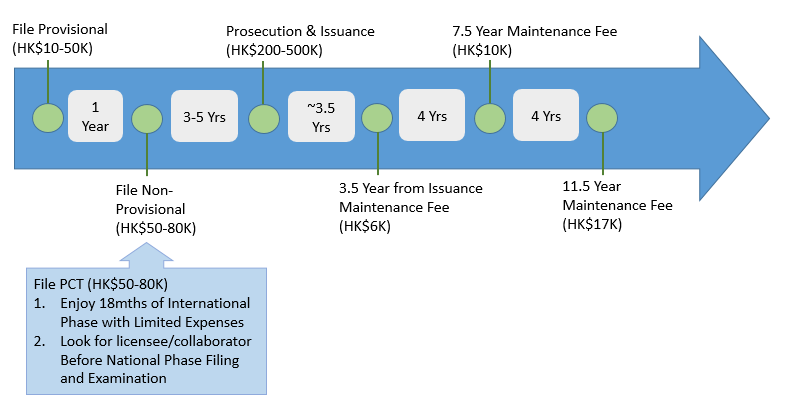
-
Should I apply patent applications for all my inventions?
Apart from patentability, market potential/marketability should be taken into consideration. As applying patent is a costly activity (e.g., typical cost for a US Non-Provisional Patent: HK$300,000 ‒ HK$500,000; PCT Application: HK$80,000 ‒ HK$100,000 (not including national phase entry) and Chinese Patent: HK$150,000 ‒ HK$250,000), it is encouraged to study the potential market size and value beforehand.
-
Shall I file a patent before publication?
Apart from patentability, market potential/marketability should be taken into consideration. As applying patent is a costly activity (e.g., typical cost for a US Non-Provisional Patent: HK$300,000 ‒ HK$500,000; PCT Application: HK$80,000 ‒ HK$100,000 (not including national phase entry) and Chinese Patent: HK$150,000 ‒ HK$250,000), it is encouraged to study the potential market size and value beforehand.
-
How does the provisional patent strategy help with my IP protection?
A provisional patent application is a relatively simple application for which no examination is required by the patent office. Filing a provisional patent application not only allows the inventors to quickly secure a “priority date” of which the invention is filed, it also gives the inventors additional time to decide whether a regular patent application should be filed within the next 12 months. Given the much less cost and flexibility in filing, provisional patent before a regular (non-provisional) application has been one of the most cost-effective and widely-used strategies for intellectual property (IP) protection through patent filing.
-
How ORKTS can help with my patent filing?
According to Paragraph 8.1 of the University’s Policy on Intellectual Property, colleagues can report an invention derived from a CUHK research project by providing ORKTS with a completed Invention Disclosure Form. ORKTS will review the information provided in the Invention Disclosure Form and assist the inventors to formulate appropriate patent filing strategies.
-
What are the funding available at the University for patent filing?
The University’s Patent Application Fund (PAF) is an internal funding scheme which seeks to raise awareness of the importance and benefits of Intellectual Property protection, and to encourage CUHK faculty members to seek protection for any intellectual property rights arising out of their research. The inventors may also use other funding such as their project funding (e.g., ITF), Departmental funding, or Personal funding as outlined in the Invention Disclosure Form to support patent filing.
-
How do I apply for the Patent Application Fund through ORKTS?
The inventors shall discuss with ORKTS with an Invention Disclosure Form first. ORKTS will prepare a PAF application memo to be submitted to the Patent Committee (PC) for further review. An interview with the inventors will be organized so that the PC members can communicate direct with the inventions. The PAF application will be assessed based on the commercial potential and scientific merit of the invention. Please refer to the PAF Funding Guidelines for further details.
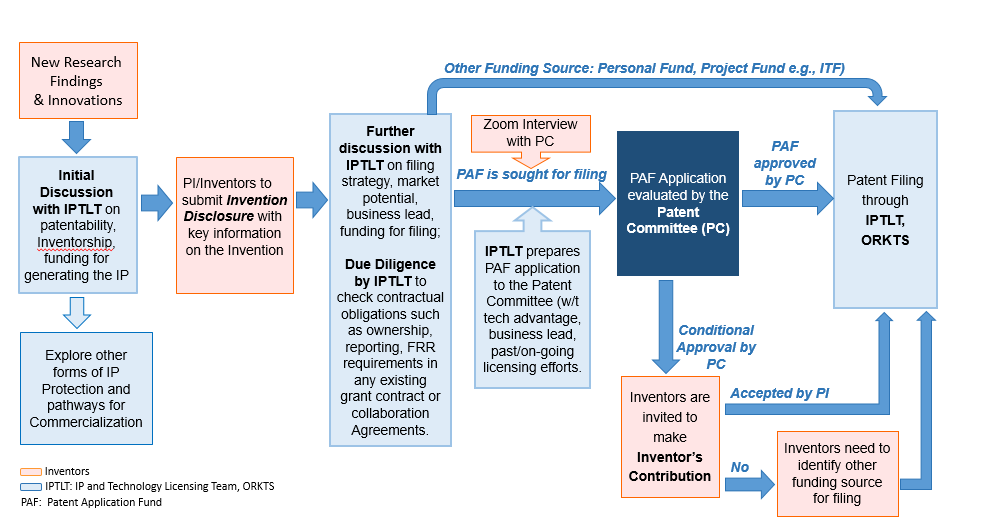
-
What shall I do if I receive a Conditional Approval for my PAF application?
The applicant will be invited to consider making a reimbursable Inventor Contribution from their personal source. With the Inventor Contribution, the PAF application will be approved and ORKTS will handle the patent filing on behalf of the University; However if the applicant chooses to file the pertinent patent application with other funding sources, he/she shall provide ORKTS with the funding details for further handling. Please refer to the PAF Funding Guidelines for further details.
-
How does Inventor Contribution work under PAF? Will it affect future licensing income attributable to me?
The applicant can choose to make a reimbursable “Inventor Contribution” (the Contribution) using funding from personal source to demonstrate the commitment to the patent application and subsequent IP commercialization. Such commitment, if so wished, had to be indicated in the Invention Disclosure Form at the beginning of the PAF application for the consideration of the PC. The Contribution will be reimbursed to the inventor when there is income generated from the invention and being sufficient for the reimbursement. Such Contribution will not affect the share of income attributable to Inventors as per University policy. Please refer to the PAF Funding Guidelines for further details.
-
How do I commercialize my patent?
There are many ways to commercialize an IP. For instance, the patent can be transferred to a company (in the form of patent license) for further development. Alternatively, the Inventors can form their own company (e.g., a technology start-up) and get a patent license from the University. The inventors can also engage in collaborative/sponsored research with a company for joint-development of the invention.
-
How to get an IP license from the University?
IP Licensing has been one of the most effective pathways to bring University innovations to the industry and market. ORKTS provides a wide range of support in IP licensing from seeking licensees and facilitating the negotiation of terms. A potential licensee can be found at industry events, or through market research, invitation for Expression of Interest (EoI) to the Industry, IP listing platforms, or inventors’ own connection built through their publications. Once an initial offer is received from a potential licensee, IP and Technology Licensing Team (IP Team) at ORKTS will perform the due diligence, review the terms, then lead the negotiation on commercial and legal terms until agreements is reached between all parties. A license agreement will be drafted, reviewed, and revised until there is approval from all parties.
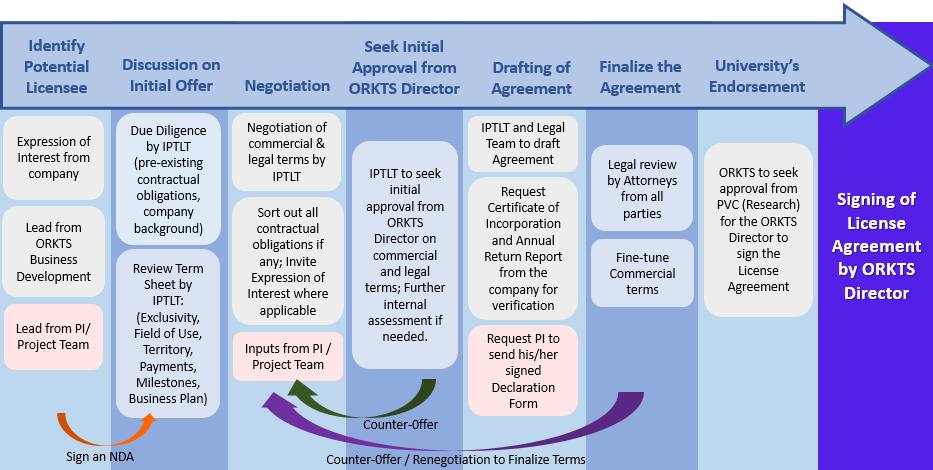
-
What are CUHK’s IP licensing terms?
Usually licensing terms are negotiable and will be considered on a case-by-case basis. The most common financial terms in a license would include (i) upfront payment, (ii) a fixed per-unit royalty or a royalty as a percentage of sales, and (iii) a minimum annual guarantee (MAG) royalty amount per year. Licensees who are interested in taking licenses of CUHK’s invention may submit a Term Sheet proposing their terms to CUHK for further discussion. The terms will be reviewed by ORKTS and approval will be sought from the management including ORKTS Director.
-
How is a company chosen to be a IP licensee?
Although it is rare to have multiple licensees bidding on an invention simultaneously, the company with established business, experience in similar industries, and ability to commercialize the technology for the greatest public interest, will normally be the best choice.
-
What is an Invitation for Expression of Interest (EoI)? When is it required?
Invitation for expression of interest means a public invitation made by the University seeking responses from potential licensees who may be interested in taking licenses of a technology from the University. Potential licensees are requested to send their proposed licensing terms with a business plan to the University. It is a procedure often required for granting an exclusive license to a potential licensee.
-
How will I, as an inventor benefit from my licensed IP? What is the income sharing arrangement for inventors?
If your technology is successfully licensed, part of the income from licensing revenues will be distributed back to the inventors, with the remaining divided between the UCF and Faculty. Please refer to the University’s Policy on Intellectual Property for details.
For PAF Funding Guidelines, please download here.
For Invention Disclosure Form, please download here.
- Details
- Category: Knowledge Transfer
- Details
- Category: Knowledge Transfer
